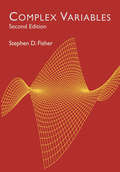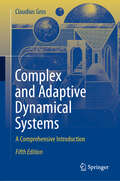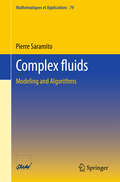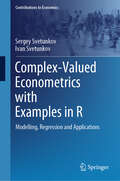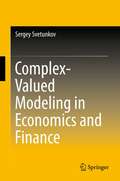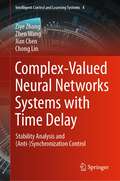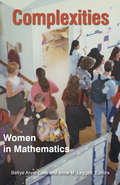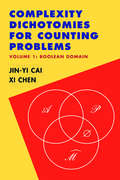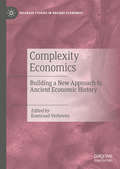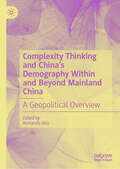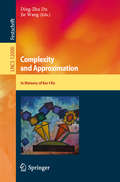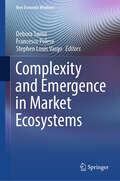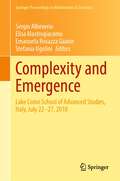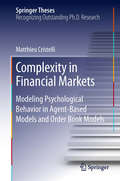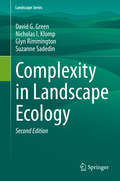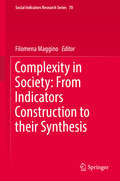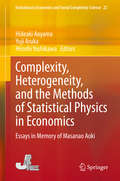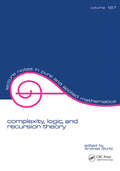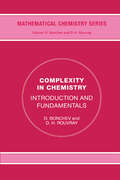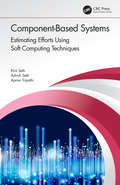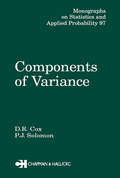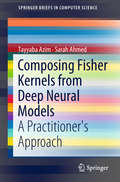- Table View
- List View
Complex Variables: Second Edition
by Stephen D. FisherThe most important topics in the theory and application of complex variables receive a thorough, coherent treatment in this introductory text. Intended for undergraduates or graduate students in science, mathematics, and engineering, this volume features hundreds of solved examples, exercises, and applications designed to foster a complete understanding of complex variables as well as an appreciation of their mathematical beauty and elegance. Prerequisites are minimal; a three-semester course in calculus will suffice to prepare students for discussions of these topics: the complex plane, basic properties of analytic functions (including a rewritten and reorganized discussion of Cauchy's Theorem), analytic functions as mappings, analytic and harmonic functions in applications, and transform methods. Useful appendixes include tables of conformal mappings and Laplace transforms, as well as solutions to odd-numbered exercises.Students and teachers alike will find this volume, with its well-organized text and clear, concise proofs, an outstanding introduction to the intricacies of complex variables.
Complex and Adaptive Dynamical Systems: A Comprehensive Introduction
by Claudius GrosThis textbook offers a comprehensive introduction to the concepts underpinning our modern understanding of complex and emergent behavior. Mathematical methods necessary for the discussion are introduced and explained on the run. All derivations are presented step-by-step. This new fifth edition has been fully revised and includes a new chapter, a range of new sections, figures and exercises. The Solution chapter has been reorganized for clarity.The core aspects of modern complex system sciences are presented in the first chapters, covering the foundations of network- and dynamical system theory, with a particular focus on scale-free networks and tipping phenomena. The notion of deterministic chaos is treated together with bifurcation theory and the intricacies of time delays. Modern information theoretical principles are discussed in further chapters, together with the notion of self-organized criticality, synchronization phenomena, and a game-theoretical treatment of the tragedy of the commons. The dynamical systems view of modern machine learning is presented in a new chapter.Chapters include exercises and suggestions for further reading. The textbook is suitable for graduate and advanced undergraduate students. The prerequisites are the basic mathematical tools of courses in natural sciences, computer science or engineering.
Complex and Symplectic Geometry (Springer INdAM #21)
by Daniele Angella Costantino Medori Adriano TomassiniThis book arises from the INdAM Meeting "Complex and Symplectic Geometry", which was held in Cortona in June 2016. Several leading specialists, including young researchers, in the field of complex and symplectic geometry, present the state of the art of their research on topics such as the cohomology of complex manifolds; analytic techniques in K#65533;hler and non-K#65533;hler geometry; almost-complex and symplectic structures; special structures on complex manifolds; and deformations of complex objects. The work is intended for researchers in these areas.
Complex fluids: Modeling and Algorithms (Mathématiques et Applications #79)
by Pierre SaramitoThis book presents a comprehensive overview of the modeling of complex fluids, including many common substances, such as toothpaste, hair gel, mayonnaise, liquid foam, cement and blood, which cannot be described by Navier-Stokes equations. It also offers an up-to-date mathematical and numerical analysis of the corresponding equations, as well as several practical numerical algorithms and software solutions for the approximation of the solutions. It discusses industrial (molten plastics, forming process), geophysical (mud flows, volcanic lava, glaciers and snow avalanches), and biological (blood flows, tissues) modeling applications. This book is a valuable resource for undergraduate students and researchers in applied mathematics, mechanical engineering and physics.
Complex-Valued Econometrics with Examples in R: Modelling, Regression and Applications (Contributions to Economics)
by Sergey Svetunkov Ivan SvetunkovThis book explores the application of complex variables to econometric modeling. Providing a thorough introduction to the theory of complex numbers, it extends these concepts to develop complex-valued models that enhance the accuracy and depth of economic forecasting and data analysis. From simple to multiple complex linear regression, the monograph discusses model formulation, estimation techniques, and correlation analysis, supported by examples in R. This comprehensive guide is a useful resource for students, researchers, and practitioners aiming to apply advanced mathematical techniques to tackle complex real-life problems, making it a useful tool for enhancing predictive analytics in business, economics, and finance.
Complex-Valued Modeling in Economics and Finance
by Sergey SvetunkovComplex-Valued Modeling in Economics and Finance outlines the theory, methodology, and techniques behind modeling economic processes using complex variables theory. The theory of complex variables functions is widely used in many scientific fields, since work with complex variables can appropriately describe different complex real-life processes. Many economic indicators and factors reflecting the properties of the same object can be represented in the form of complex variables. By describing the relationship between various indicators using the functions of these variables, new economic and financial models can be created which are often more accurate than the models of real variables. This book pays critical attention to complex variables production in stock market modeling, modeling illegal economy, time series forecasting, complex auto-aggressive models, and economic dynamics modeling. Very little has been published on this topic and its applications within the fields of economics and finance, and this volume appeals to graduate-level students studying economics, academic researchers in economics and finance, and economists.
Complex-Valued Neural Networks Systems with Time Delay: Stability Analysis and (Anti-)Synchronization Control (Intelligent Control and Learning Systems #4)
by Jian Chen Zhen Wang Ziye Zhang Chong LinThis book provides up-to-date developments in the stability analysis and (anti-)synchronization control area for complex-valued neural networks systems with time delay. It brings out the characteristic systematism in them and points out further insight to solve relevant problems. It presents a comprehensive, up-to-date, and detailed treatment of dynamical behaviors including stability analysis and (anti-)synchronization control. The materials included in the book are mainly based on the recent research work carried on by the authors in this domain.The book is a useful reference for all those from senior undergraduates, graduate students, to senior researchers interested in or working with control theory, applied mathematics, system analysis and integration, automation, nonlinear science, computer and other related fields, especially those relevant scientific and technical workers in the research of complex-valued neural network systems, dynamic systems, and intelligent control theory.
Complexities: Women in Mathematics
by Anne M. Leggett Bettye Anne CaseSophie Germain taught herself mathematics by candlelight, huddled in her bedclothes. Ada Byron Lovelace anticipated aspects of general-purpose digital computing by more than a century. Cora Ratto de Sadosky advanced messages of tolerance and equality while sharing her mathematical talents with generations of students. This captivating book gives voice to women mathematicians from the late eighteenth century through to the present day. It documents the complex nature of the conditions women around the world have faced--and continue to face--while pursuing their careers in mathematics. The stories of the three women above and those of many more appear here, each one enlightening and inspiring. The earlier parts of the book provide historical context and perspective, beginning with excursions into the lives of fifteen women born before 1920. Included are histories of collective efforts to improve women's opportunities in research mathematics. In addition, a photo essay puts a human face on the subject as it illustrates women's contributions in professional associations. More than eighty women from academe, government, and the private sector provide a rich mélange of insights and strategies for creating workable career paths while maintaining rewarding personal lives. The book discusses related social and cultural issues, and includes a summary of recent comparative data relating to women and men in mathematics and women from other sciences. First-person accounts provide explicit how-tos; many narratives demonstrate great determination and perseverance. Talented women vividly portray their pleasure in discovering new mathematics. The senior among them speak out candidly, interweaving their mathematics with autobiographical detail. At the beginning of a new century, women at all stages of their careers share their outlooks and experiences. Clear, engaging, and meticulously researched, Complexities will inspire young women who are contemplating careers in mathematics and will speak to women in many fields of endeavor and walks of life.
Complexity Dichotomies for Counting Problems
by Xi Chen Jin-Yi CaiComplexity theory aims to understand and classify computational problems, especially decision problems, according to their inherent complexity. This book uses new techniques to expand the theory for use with counting problems. The authors present dichotomy classifications for broad classes of counting problems in the realm of P and NP. Classifications are proved for partition functions of spin systems, graph homomorphisms, constraint satisfaction problems, and Holant problems. The book assumes minimal prior knowledge of computational complexity theory, developing proof techniques as needed and gradually increasing the generality and abstraction of the theory. This volume presents the theory on the Boolean domain, and includes a thorough presentation of holographic algorithms, culminating in classifications of computational problems studied in exactly solvable models from statistical mechanics.
Complexity Economics: Building a New Approach to Ancient Economic History (Palgrave Studies in Ancient Economies)
by Koenraad VerbovenEconomic archaeology and ancient economic history have boomed the past decades. The former thanks to greatly enhanced techniques to identify, collect, and interpret material remains as proxies for economic interactions and performance; the latter by embracing the frameworks of new institutional economics. Both disciplines, however, still have great difficulty talking with each other. There is no reliable method to convert ancient proxy-data into the economic indicators used in economic history. In turn, the shared cultural belief-systems underlying institutions and the symbolic ways in which these are reproduced remain invisible in the material record. This book explores ways to bring both disciplines closer together by building a theoretical and methodological framework to evaluate and integrate archaeological proxy-data in economic history research. Rather than the linear interpretations offered by neoclassical or neomalthusian models, we argue that complexity economics, based on system theory, offers a promising way forward.
Complexity Science
by Vassili Kolokoltsov Robin Ball Robert S. MackayComplexity science is the study of systems with many interdependent components. Such systems - and the self-organization and emergent phenomena they manifest - lie at the heart of many challenges of global importance. This book is a coherent introduction to the mathematical methods used to understand complexity, with plenty of examples and real-world applications. It starts with the crucial concepts of self-organization and emergence, then tackles complexity in dynamical systems using differential equations and chaos theory. Several classes of models of interacting particle systems are studied with techniques from stochastic analysis, followed by a treatment of the statistical mechanics of complex systems. Further topics include numerical analysis of PDEs, and applications of stochastic methods in economics and finance. The book concludes with introductions to space-time phases and selfish routing. The exposition is suitable for researchers, practitioners and students in complexity science and related fields at advanced undergraduate level and above.
Complexity Thinking and China’s Demography Within and Beyond Mainland China: A Geopolitical Overview
by Armando AliuThis book uses complexity thinking to explore China’s demography and population-driven geopolitics within and beyond mainland China. From a multidisciplinary perspective, the book is relevant to the debates of Chinese demography studies and politics of contemporary China. It combines international relations approaches, demography research, and legal studies to conceive the recent demographic trends and social transformations in China and across the world. The book prioritizes the anthropological viewpoint to provide a better understanding of demographic phenomena and combine an anthropological demography perspective with complexity thinking and geopolitics. This book will interest scholars of China, of geopolitics, and demographers.
Complexity and Approximation: In Memory of Ker-I Ko (Lecture Notes in Computer Science #12000)
by Ding-Zhu Du Jie WangThis Festschrift is in honor of Ker-I Ko, Professor in the Stony Brook University, USA. Ker-I Ko was one of the founding fathers of computational complexity over real numbers and analysis. He and Harvey Friedman devised a theoretical model for real number computations by extending the computation of Turing machines. He contributed significantly to advancing the theory of structural complexity, especially on polynomial-time isomorphism, instance complexity, and relativization of polynomial-time hierarchy. Ker-I also made many contributions to approximation algorithm theory of combinatorial optimization problems. This volume contains 17 contributions in the area of complexity and approximation. Those articles are authored by researchers over the world, including North America, Europe and Asia. Most of them are co-authors, colleagues, friends, and students of Ker-I Ko.
Complexity and Emergence in Market Ecosystems (New Economic Windows)
by Francesco Polese Debora Sarno Stephen Louis VargoThis book delves into the intricacies of transformative processes, focusing particularly on radical and disruptive changes that shape markets, social systems, organizations, cities, and service ecosystems. In a world characterized by turbulence, unpredictability, and complex challenges, managers and marketers are tasked with navigating change and driving progress. Drawing on frameworks, typologies, and insights from diverse theories—including complexity theory, emergence theory, and service-dominant logic—this book equips academics and practitioners with the tools to analyze, understand, and facilitate the transformation of their systems. Rooted in research and discussions from international academic events such as the Naples Forum on Service and the Forum of Markets and Marketing, this book offers invaluable guidance for those seeking to design sustainable transformations in today's dynamic landscape.
Complexity and Emergence: Lake Como School of Advanced Studies, Italy, July 22–27, 2018 (Springer Proceedings in Mathematics & Statistics #383)
by Sergio Albeverio Emanuela Rosazza Gianin Stefania Ugolini Elisa MastrogiacomoThis book includes contributions about mathematics, physics, philosophy of science, economics and finance and resulted from the Summer School “Complexity and Emergence: Ideas, Methods, with a Special Attention to Economics and Finance” held in Lake Como School of Advanced Studies, on 22–27 July 2018.The aim of the book is to provide useful instruments from the theory of complex systems, both on the theoretical level and the methodological ones, profiting from knowledge and insights from leading experts of different communities. It moves from the volume editors' conviction that to achieve progress in understanding socio-economical as well as ecological problems of our complex word such preparation is needed, together with a critical reconsideration of our basic scientific and economical approach.The potential readers are primarily master and doctorate students of mathematics, information sciences, theoretical physics and economics, as well as research workers in those areas, who want to enlarge their spectrum of knowledge towards the area of complexity and emergence. Since ideas and methods of the theory of complex systems also apply to other areas (from engineering and architecture to biology and medicine, e.g.), students and research workers from those areas will also profit from this book.
Complexity in Financial Markets: Modeling Psychological Behavior in Agent-Based Models and Order Book Models (Springer Theses)
by Matthieu CristelliTools and methods from complex systems science can have a considerable impact on the way in which the quantitative assessment of economic and financial issues is approached, as discussed in this thesis. First it is shown that the self-organization of financial markets is a crucial factor in the understanding of their dynamics. In fact, using an agent-based approach, it is argued that financial markets' stylized facts appear only in the self-organized state. Secondly, the thesis points out the potential of so-called big data science for financial market modeling, investigating how web-driven data can yield a picture of market activities: it has been found that web query volumes anticipate trade volumes. As a third achievement, the metrics developed here for country competitiveness and product complexity is groundbreaking in comparison to mainstream theories of economic growth and technological development. A key element in assessing the intangible variables determining the success of countries in the present globalized economy is represented by the diversification of the productive basket of countries. The comparison between the level of complexity of a country's productive system and economic indicators such as the GDP per capita discloses its hidden growth potential.
Complexity in Landscape Ecology (Landscape Series #22)
by David G. Green Nicholas I. Klomp Glyn Rimmington Suzanne SadedinThis book examines key concepts and analytical approaches in complexity theory as it applies to landscape ecology, including complex networks, connectivity, criticality, feedback, and self-organisation. It then reviews the ways that these ideas have led to new insights into the nature of ecosystems and the role of processes in landscapes. The updated edition explores innovations in ecotechnology, including automated monitoring, big data, simulation and machine learning, and shows how they are revolutionizing ecology by making it possible to deal more effectively with complexity. Addressing the topic in a progression of ideas from small to large, and from simple to sophisticated, the book examines the implications of complexity for major environmental issues of our time, particularly the urgencies of climate change and loss of biodiversity. Understanding ecological complexity is crucial in today’s globalized and interconnected world. Successful management of the world’s ecosystems must combine models of ecosystem complexity with biodiversity, environmental, geographic, and socioeconomic data. The book examines the impact of humans on landscapes and ecosystems, as well as efforts to embed sustainability, commerce and industrial development in the larger context of ecosystem services and ecological economics. Well-established as researchers in the field, the authors provide a new perspective on current and future understanding of complexity in landscape ecology. The new edition offers a non-technical account of the topic, so it is both accessible and informative for general readers. For students of ecology, it provides a fresh approach to classical ideas.
Complexity in Society: From Indicators Construction to their Synthesis (Social Indicators Research Series #70)
by Filomena MagginoThis volume discusses the many recent significant developments, and identifies important problems, in the field of social indicators. In the last ten years the methodology of multivariate analysis and synthetic indicators construction significantly developed. In particular, starting from the classical theory of composite indicators many interesting approaches have been developed to overcome the weaknesses of composites. This volume focuses on these recent developments in synthesizing indicators, and more generally, in quantifying complex phenomena.
Complexity in Tsunamis, Volcanoes, and their Hazards (Encyclopedia of Complexity and Systems Science Series)
by Robert I. TillingThis volume of the Encyclopedia of Complexity and Systems Science, Second Edition is an authoritative single source for understanding and applying the basic tenets of complexity and systems theory, as well as the tools and measures for analyzing complex systems, to the prediction, monitoring, and evaluation of earthquakes, tsunamis, and volcanoes. Early warning, damage, and the immediate response of human populations to these extreme environmental events are also covered from the point of view of complexity and nonlinear systems. In authoritative, state-of-the art articles, world experts in each field apply such complexity tools and concepts as fractals, cellular automata, solitons game theory, network theory, and statistical physics to an understanding of these complex geophysical phenomena.
Complexity, Heterogeneity, and the Methods of Statistical Physics in Economics: Essays in Memory of Masanao Aoki (Evolutionary Economics and Social Complexity Science #22)
by Hideaki Aoyama Yuji Aruka Hiroshi YoshikawaThis book systematically provides a prospective integrated approach for complexity social science in its view of statistical physics and mathematics, with an impressive collection of the knowledge and expertise of leading researchers from all over the world. The book mainly covers both finitary methods of statistical equilibrium and data-driven analysis by econophysics. The late Professor Masanao Aoki of UCLA, who passed away at the end of July 2018, in his later years dedicated himself to the reconstruction of macroeconomics mainly in terms of statistical physics. Professor Aoki, who was already an IEEE fellow, was also named an Econometric Society Fellow in 1979. Until the early 1990s, however, his contributions were focused on the new developments of a novel algorithm for the time series model and their applications to economic data. Those contributions were undoubtedly equivalent to the Nobel Prize-winning work of Granger's "co-integration method". After the publications of his New Approaches to Macroeconomic Modeling and Modeling Aggregate Behavior and Fluctuations in Economics, both published by Cambridge University Press, in 1996 and 2002, respectively, his contributions rapidly became known and spread throughout the field. In short, these new works challenged econophysicists to develop evolutionary stochastic dynamics, multiple equilibria, and externalities as field effects and revolutionized the stochastic views of interacting agents. In particular, the publication of Reconstructing Macroeconomics, also by Cambridge University Press (2007), in cooperation with Hiroshi Yoshikawa, further sharpened the process of embodying “a perspective from statistical physics and combinatorial stochastic processes” in economic modeling. Interestingly, almost concurrently with Prof. Aoki’s newest development, similar approaches were appearing. Thus, those who were working in the same context around the world at that time came together, exchanging their results during the past decade. In memory of Prof. Aoki, this book has been planned by authors who followed him to present the most advanced outcomes of his heritage.
Complexity, Logic, and Recursion Theory (Lecture Notes in Pure and Applied Mathematics #Vol. 187)
by Andrea Sorbi"Integrates two classical approaches to computability. Offers detailed coverage of recent research at the interface of logic, computability theory, nd theoretical computer science. Presents new, never-before-published results and provides informtion not easily accessible in the literature."
Complexity: Introduction and Fundamentals
by Danail Bonchev Dennis H. RouvrayThis volume covers the rapidly developing field of complexity studies with the underlying theme that complexity is to be found everywhere. The volume discusses many chemical applications and offers a comprehensive coverage of complexity and the ways in which it may be measured, complexity indices, complexity measures based on Shannon's information
Component-Based Systems: Estimating Efforts Using Soft Computing Techniques
by Kirti Seth Ashish Seth Aprna TripathiBusinesses today are faced with a highly competitive market and fast-changing technologies. In order to meet demanding customers’ needs, they rely on high quality software. A new field of study, soft computing techniques, is needed to estimate the efforts invested in component-based software. Component-Based Systems: Estimating Efforts Using Soft Computing Techniques is an important resource that uses computer-based models for estimating efforts of software. It provides an overview of component-based software engineering, while addressing uncertainty involved in effort estimation and expert opinions. This book will also instruct the reader how to develop mathematical models. This book is an excellent source of information for students and researchers to learn soft computing models, their applications in software management, and will help software developers, managers, and those in the industry to apply soft computing techniques to estimate efforts.
Components of Variance (Chapman & Hall/CRC Monographs on Statistics and Applied Probability)
by D.R. Cox P.J. SolomonThe components of variance is a notion essential to statisticians and quantitative research scientists working in a variety of fields, including the biological, genetic, health, industrial, and psychological sciences. Co-authored by Sir David Cox, the pre-eminent statistician in the field, this book provides in-depth discussions that set forth the essential principles of the subject. It focuses on developing the models that form the basis for detailed analyses as well as on the statistical techniques themselves. The authors include a variety of examples from areas such as clinical trial design, plant and animal breeding, industrial design, and psychometrics.
Composing Fisher Kernels from Deep Neural Models: A Practitioner's Approach (SpringerBriefs in Computer Science)
by Tayyaba Azim Sarah AhmedThis book shows machine learning enthusiasts and practitioners how to get the best of both worlds by deriving Fisher kernels from deep learning models. In addition, the book shares insight on how to store and retrieve large-dimensional Fisher vectors using feature selection and compression techniques. Feature selection and feature compression are two of the most popular off-the-shelf methods for reducing data’s high-dimensional memory footprint and thus making it suitable for large-scale visual retrieval and classification. Kernel methods long remained the de facto standard for solving large-scale object classification tasks using low-level features, until the revival of deep models in 2006. Later, they made a comeback with improved Fisher vectors in 2010. However, their supremacy was always challenged by various versions of deep models, now considered to be the state of the art for solving various machine learning and computer vision tasks. Although the two research paradigms differ significantly, the excellent performance of Fisher kernels on the Image Net large-scale object classification dataset has caught the attention of numerous kernel practitioners, and many have drawn parallels between the two frameworks for improving the empirical performance on benchmark classification tasks. Exploring concrete examples on different data sets, the book compares the computational and statistical aspects of different dimensionality reduction approaches and identifies metrics to show which approach is superior to the other for Fisher vector encodings. It also provides references to some of the most useful resources that could provide practitioners and machine learning enthusiasts a quick start for learning and implementing a variety of deep learning models and kernel functions.
